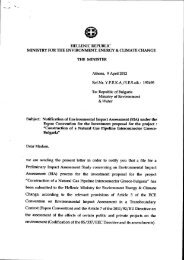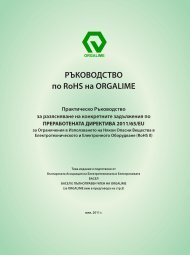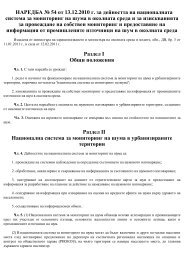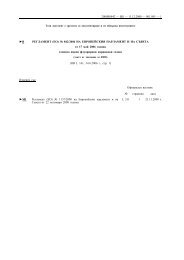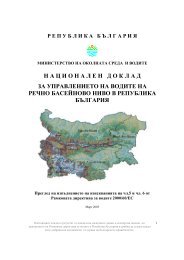Програма на научната конференция - Министерство на ...
Програма на научната конференция - Министерство на ...
Програма на научната конференция - Министерство на ...
- No tags were found...
Create successful ePaper yourself
Turn your PDF publications into a flip-book with our unique Google optimized e-Paper software.
MACROZOOBENTHOS OF THE VIT RIVER BASIN – AN ECOLOGICALASSESSMENTM. Pavlova, L. PehlivanovCentral Laboratory of General Ecology, Bulgarian Academy of Sciences,2 Gagarin Stret, 1113 Sofia, Bulgaria; nikolovamilena@abv.bgSeven sites within the Vit River basin were examined in 2009 during the summerlow water period. The species composition of macrozoobenthic communities wasrevealed. One hundred and three taxa belonging to 20 benthic groups were found.Eight new macrozoobenthic species for the Vit River and for the Bulgarian Danubetributaries are reported. One of them, the clam Corbiculla fluminea is consideredan invasive species according to the Global Invasive Species Database. Saprobicand biotic indices as well as some structure parameters of the benthic communitieswere used for complete ecological assessment together with the relevant physicochemicalparameters. Significant changes in the ecological state of the Vit Riverwere found in comparison with data of previous investigations from the earlynineties of the 20 th century. Olygosaprobity and β-mesosaprobity were found to becharacteristic for all the watershed, corresponding to “very good” and “good”ecological status, respectively. Anthropogenic impact associated with an increasedorganic content in the water was detected downstream the towns through theexamined parameters of the macrozoobenthos. Considerable self-purificationability of the Vit River was found. Further examination of the fine mechanisms ofthe river ecosystem functioning using the trophic structure of the hydrozoocenosescould be very important for revealing the natural succession and also for predictionof the anthropogenic influence over the watershed.14:45-15:00ТРАНСФОРМАЦИЯ НА ВКИСЛЯВАЩИ АТМОСФЕРНИЗАМЪРСИТЕЛИ ОТ РАСТИТЕЛНОСТТА В ГРАД СОФИЯ И ПЛАНАПЛАНИНАР. Фикова 1 , П. Първанова 1 , Н. Иг<strong>на</strong>това 2 , Р. Христова 1 , С. Дамянова 2 ,С. Братанова-Дончева 11 Централ<strong>на</strong> лаборатория по обща екология, БАН, 1113 София,Е-поща: fikova@ecolab.bas.bg; 2 Лесотехнически университет, СофияХимичният състав (pH, SO 4 2- , NO 3 - , NH 4 + ) <strong>на</strong> атмосферните валежи <strong>на</strong> откритаплощ, както и <strong>на</strong> тези преми<strong>на</strong>ли през короните <strong>на</strong> бук (Fagus silvatica L.),бял бор (Pinus silvestris L.) и бреза (Betula alba L.) в Пла<strong>на</strong> плани<strong>на</strong>, и <strong>на</strong> дъб(Quercus robur L. s.l.) в град София, бяха обект <strong>на</strong> мониторинг през периода2006-2008. Резултати за киселин<strong>на</strong>та реакция <strong>на</strong> валежите <strong>на</strong> откритопоказват, че в градски условия постъпват валежи с по-високи стойности <strong>на</strong>рН, в сравнение с тези от в Пла<strong>на</strong> плани<strong>на</strong>, въпреки приблизително ед<strong>на</strong>квитеконцентрации <strong>на</strong> SO 4 2- and NO 3 в дъждовните води от изследваните пунктове.30







